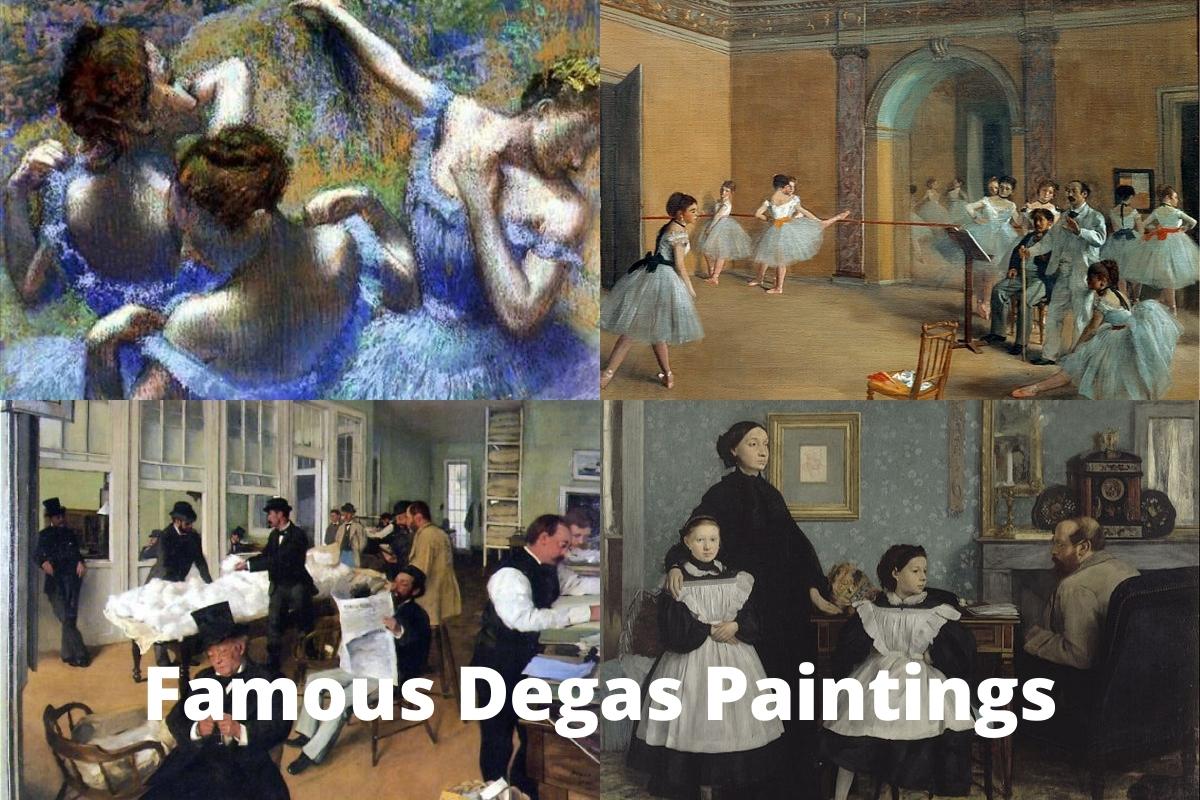Edgar Degas (27 September 1917 – 19 July 1834) was a French Impressionist painter best known for his pastel sketches and oil paintings.
Additionally, Degas created bronze sculptures, prints, and sketches. Degas is particularly well-known for his depictions of dancers; more than half of his paintings include dancers.
Although Degas is often considered as a creator of Impressionism, he rejected the label, preferring to be referred to as a realist, and did not paint outside ‘en plein air‘ in the manner of many Impressionists.
Degas was an exceptional draftsman, especially adept in capturing movement, as seen by his depictions of dancers and bathing female nudists.
Degas painted racehorses and racing jockeys, as well as portraits, in addition to ballet dancers and bathing ladies. His portraiture is remarkable for its psychological intricacy and depiction of human loneliness.
Degas initially desired a career as a history painter, for which he was well equipped by his rigorous academic schooling and intensive study of classical art.
He shifted gears in his early thirties, and by applying the conventional approaches of a history painter to current subject matter, he established himself as a classical painter of modern life.
Edgar Degas Famous Paintings
1. The Ballet Class
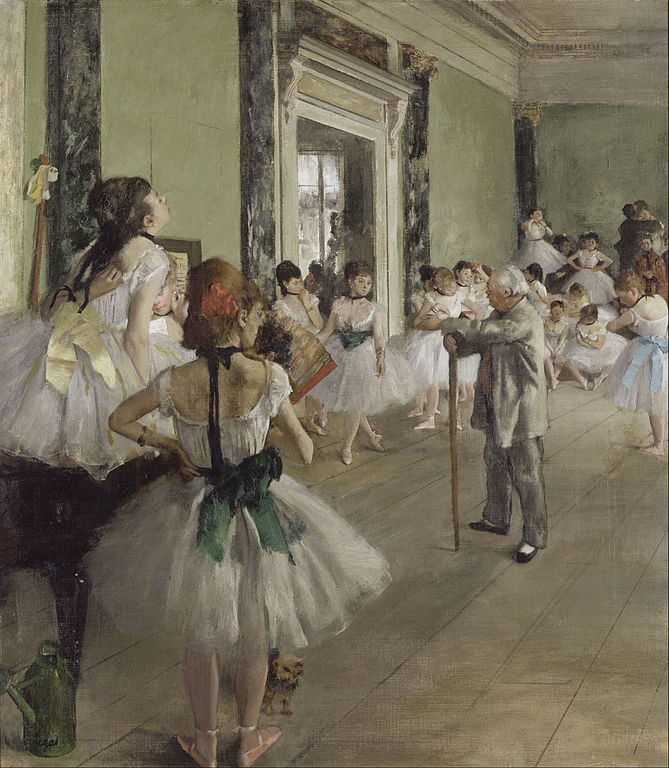
The Dance Class is an 1874 artwork by Edgar Degas that is included in the Metropolitan Museum of Art’s collection.
The painting, together with its twin piece at the Musée d’Orsay in Paris, is one of Degas’ most ambitious works on the topic of dance.
The fictitious setting shows a dancing class being taught by Jules Perrot, a prominent ballet instructor, at the old Paris Opera, which had burned down the previous year.
The poster for Rossini’s Guillaume Tell on the wall is a monument to the operatic vocalist Jean-Baptiste Faure, who commissioned the composition.
The picture is on display at Gallery 815 of the Metropolitan Museum of Art.
2. The Absinthe Drinker
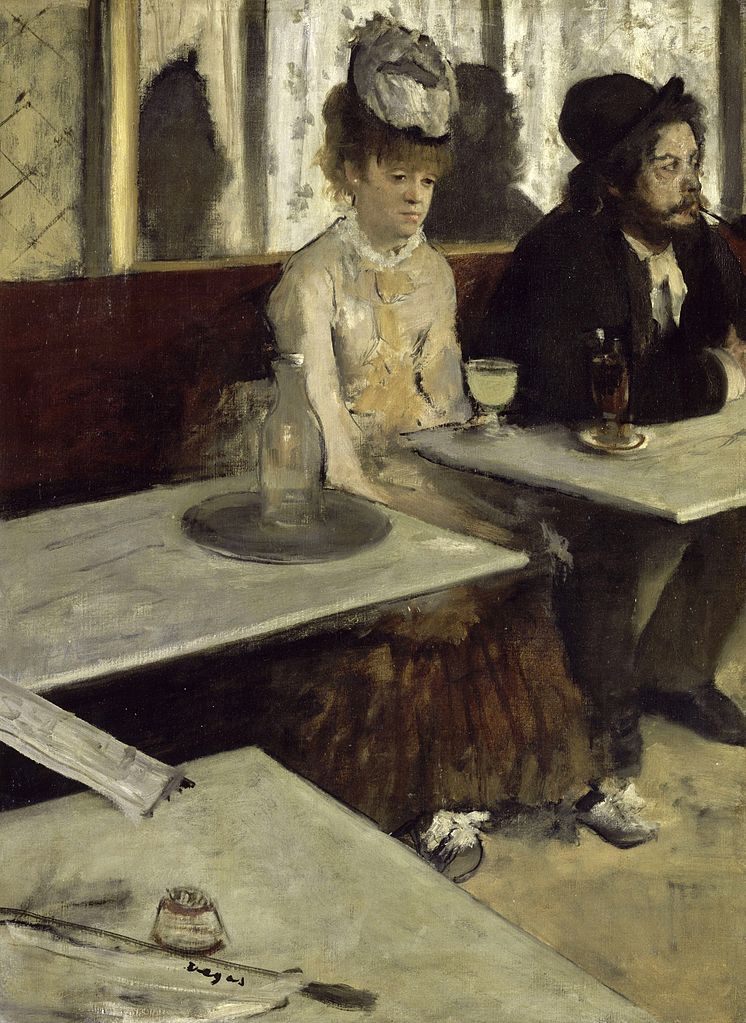
Absinthe was a popular drink throughout most of Europe in the second part of the nineteenth century. It is an unusual kind of alcoholic concoction that often causes persons who take it to become apathetic towards themselves and others.
Edgar Degas was an artist who was likely well-versed in the consequences of absinthe from both a personal and cultural viewpoint.
L’Absinthe is the title of one of Degas’ most famous works. This piece from 1876 represents what was most likely a common sight in numerous meeting areas across France and other regions of Europe.
The lady in the artwork is wearing a hat and elegant outfit, which were popular at the period in Paris and other regions of France.
Her frozen look seems to represent an unshakeable feeling of grief or melancholy, which was most likely brought on by absinthe intake.
3. Blue Dancers
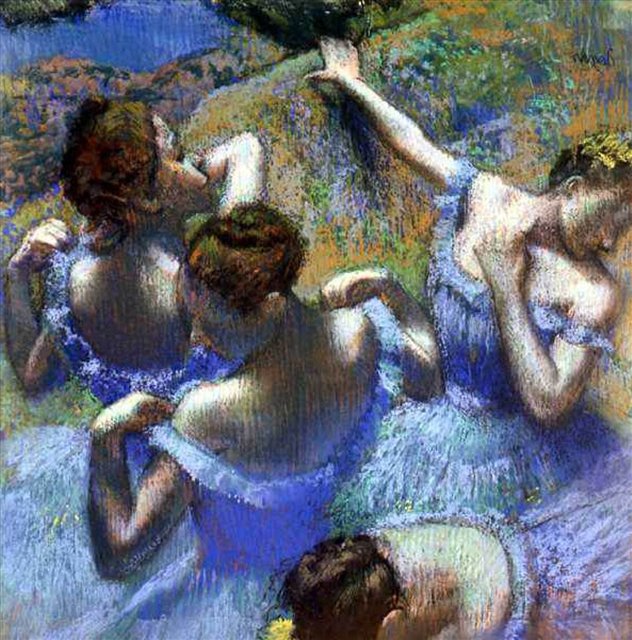
Blue Dancers is a pastel from 1897 that is presently housed at Moscow’s Pushkin Museum, where it moved there in 1948 from the State Museum of Modern Western Art. It was in Durand-collection Ruel’s for a while, and then in Sergei Shchukin’s collection in Moscow until 1918.
Degas’ favorite subject is the world of ballet. However, unlike many of his contemporaries, the artist was drawn to the prose of life off-stage rather than the brilliant spectacle of the ballet itself. Blue Dancers might be a drawing of the same dancer.
She’s lacing her ballet shoe, changing her dress, inspecting her outfit, and standing in the wings. When these commonplace motions are united on a single sheet, they transform into a magnificent dance: the enchantment of the theater and the magic of art are conjured up before our eyes. Degas creates a great depth of texture and color combinations in this painting by using the pastel media.
4. Place de la Concorde
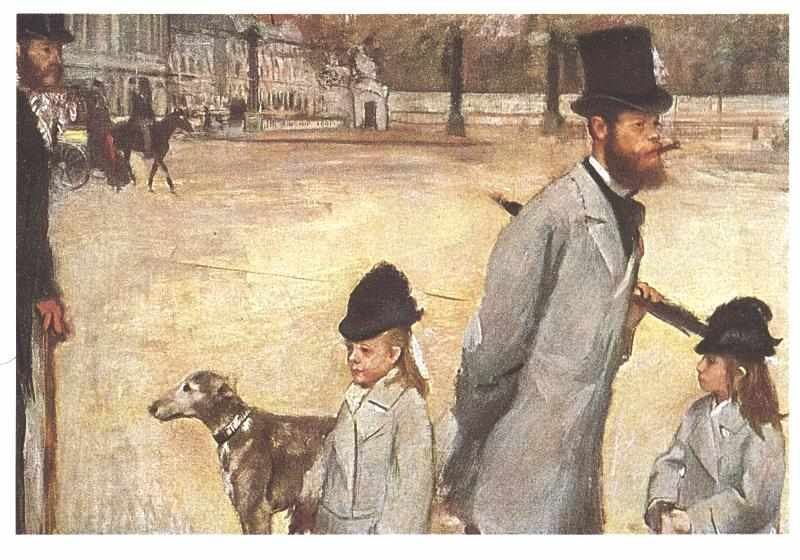
Place de la Concorde or Viscount Lepic and his Daughters Crossing the Place de la Concorde is an oil on canvas painting completed in 1879. It shows the cigar-smoking Ludovic-Napoléon Lepic, his children, his dog, and a lone guy on the left in Paris’ Place de la Concorde. The Tuileries Gardens are visible in the backdrop, hidden behind a stone wall.
Many art historians feel that photography affected the vast quantity of negative space, cropping, and the way the people face in random directions.
For four decades after World War II, the artwork was thought to be lost until Russian officials placed it on display in the Hermitage Museum in Russia, where it remains to this day.
During the Soviet occupation of Germany, the piece was taken from the possession of German art collector Otto Gerstenberg by the Soviets and subsequently relocated to the Hermitage.
5. The Bellelli Family
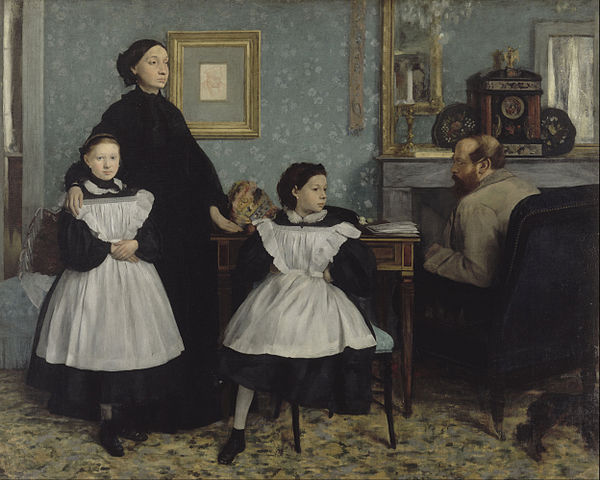
The Bellelli Family, also known as Family Portrait, is an oil painting on canvas that was completed between 1858 and 1867 and is presently on display at the Musée d’Orsay. The picture, a masterpiece of Degas’ childhood, is a portrait of his aunt, her husband, and their two small children.
Degas sketched and painted his aunt Laura, her husband, baron Gennaro Bellelli, and their children Giulia and Giovanna while continuing his artistic apprenticeship in Italy. Although it is unknown when or where Degas completed the painting, it is thought that he used sketches done in Italy to create the piece after returning to Paris.
Laura, his father’s sister, is dressed in a mourning gown for her father, who had lately died and is portrayed on the framed photo behind her. The baron was an Italian patriot residing in Florence after being banished from Naples.
6. After the Bath, Woman drying herself
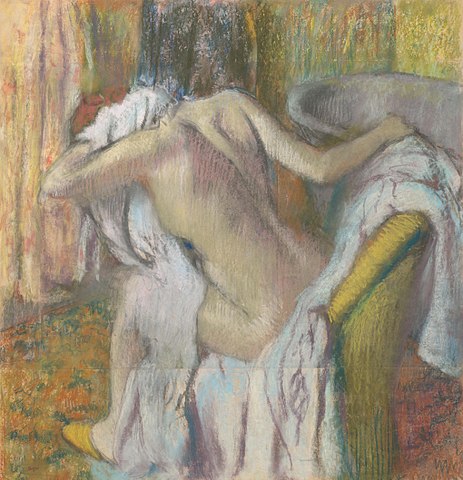
After the Bath, Woman Drying Herself is an 1890–1895 pastel artwork by Edgar Degas. It has been in the collection of the National Gallery in London since 1959.
This painting is one of a series of pastels and oils by Degas showing feminine nudity. Initially, Degas displayed his paintings at Impressionist exhibits in Paris, where he developed a devoted following.
Degas’s naked paintings, such as After the Bath, Woman Drying Herself, continue to enrage art critics.
Photographs and drawings were often utilized by Edgar Degas as a preparatory stage in researching the light and composition for his paintings. His usage of light might be attributed to his failing vision.
Degas used a lot of pastel layers in After the Bath, Lady Drying Herself to make the woman look transparent. The intensively worked pastel produces rich textures and blurred features, highlighting the movement of the figure.
7. The Dance Foyer at the Opera on the rue Le Peletier
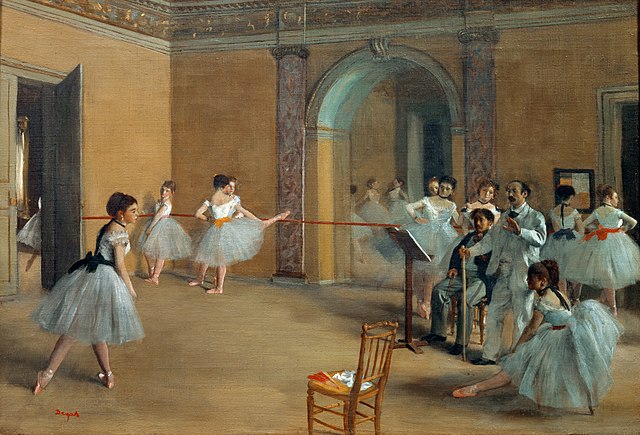
Degas started painting dancing elements in earnest about 1870. He started by drawing a series of ballet practice pictures.
Eleven ballerinas are being judged in the large auditorium of the Opera Foyer on Rue Le Peletier. The opera house’s instructor, the white-clad Louis François Mérante, is directing directions to the dancers.
Those who aren’t exercising are paying close attention to the dancer who is now being examined. The work is organized around the duality of the group and the lone individual.
The picture has a definite energy center in the vacant chair in the front, which is noticeable for the severity of its composition.
Degas used the same ballerinas in numerous of his paintings. The ballerina in the middle of the painting with the green ribbon, who is being examined by the ballet-master, appears in the monochrome Ballet Rehearsal on Stage (1874, Musee d’Orsay).
8. A Cotton Office in New Orleans
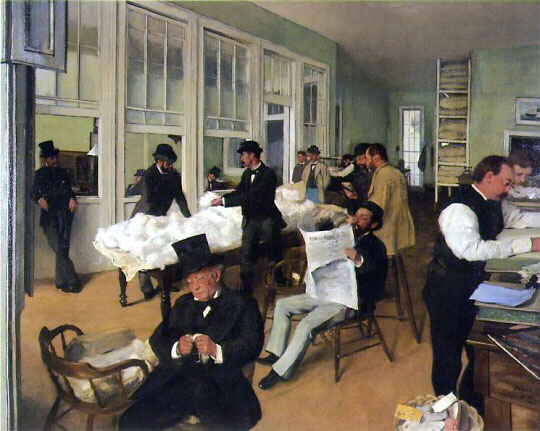
A Cotton Office in New Orleans by Edgar Degas, also known as Interior of a Cotton Buyers’ Office in New Orleans and Portraits in an Office (New Orleans), is an oil on canvas work.
In this painting, Degas represents the inside of his maternal uncle Michel Musson’s cotton business in New Orleans. Musson, Degas’s brothers René and Achille, Musson’s son-in-law William Bell, and other Musson partners are seen engaging in different business and pleasure activities, with raw cotton resting on a table in the center of the office.
During a lengthy vacation with relatives in New Orleans in early 1873, Degas made the work. His journey coincided with the political upheavals of Reconstruction. Degas displayed the painting at the Impressionist Exhibition in Paris in 1876.
9. Portrait of Mary Cassatt
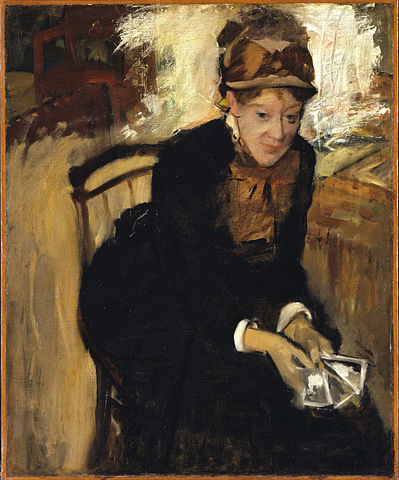
Art historians have long known that American Impressionist Cassatt and Edgar Degas collaborated closely in Paris, and many assumed their relationship was one of master and pupil — owing, in part, to the fact that Degas was ten years Cassatt’s senior.
Despite the fact that Cassatt’s image appears often in Degas’ works during this period, he only created one “official” picture of her.
The interpretation of this work is still debated: Degas may have been hinting to the collaborative nature of their relationship by depicting Cassatt in a studio environment, leaning forward in discussion, and implying that he held her in high regard.
Cassatt, on the other hand, acquired a great hatred for the picture towards the end of her life, stating it made her appear like “a repugnant person.”
10. Interior

Interior is an oil painting on canvas by Edgar Degas (1834–1917) that was completed between 1868 and 1869. It is described as “the most perplexing of Degas’s big paintings,” depicting a heated encounter between a man and a half nude lady under lamplight.
The dramatic nature of the scenario has prompted art historians to look for a literary foundation for the composition, but none of the offered sources has received general agreement.

